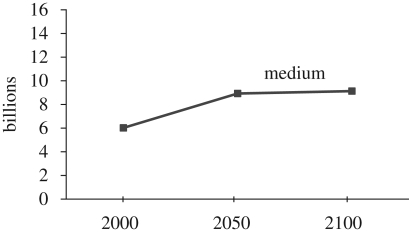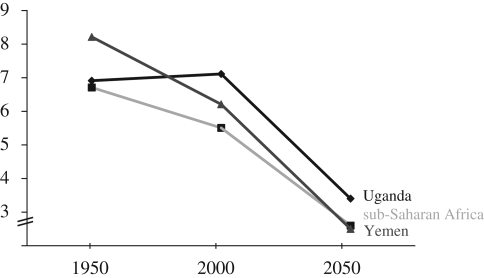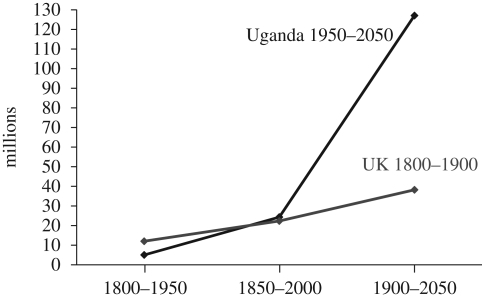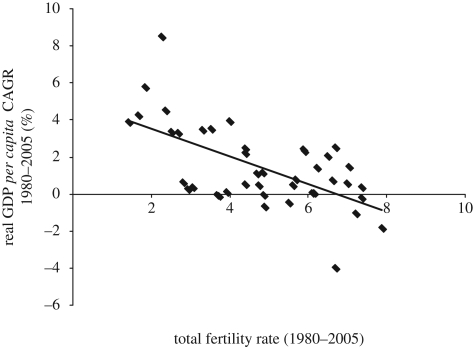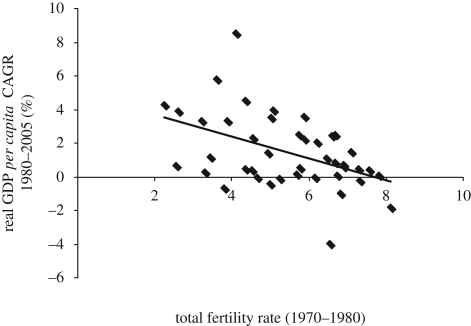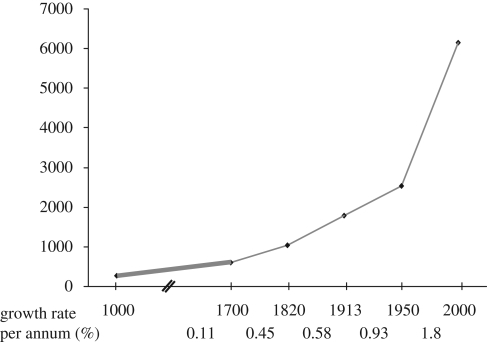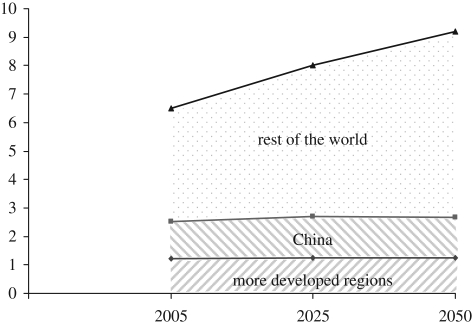Abstract
Rapid population growth continues in the least developed countries. The revisionist case that rapid population could be overcome by technology, that population density was advantageous, that capital shallowing is not a vital concern and that empirical investigations had not proved a correlation between high population growth and low per capita income was both empirically and theoretically flawed. In the modern world, population density does not play the role it did in nineteenth-century Europe and rates of growth in some of today's least developed nations are four times than those in nineteenth-century Europe, and without major accumulation of capital per capita, no major economy has or is likely to make the low- to middle-income transition. Though not sufficient, capital accumulation for growth is absolutely essential to economic growth. While there are good reasons for objecting to the enforced nature of the Chinese one-child policy, we should not underestimate the positive impact which that policy has almost certainly had and will have over the next several decades on Chinese economic performance. And a valid reticence about telling developing countries that they must contain fertility should not lead us to underestimate the severely adverse impact of high fertility rates on the economic performance and prospects of many countries in Africa and the Middle East.
Keywords: population growth, per capita income, capital accumulation, one-child policy
1. Introduction
Talk about population decline in a few rich countries has deflected discussion from the fact that the global population is still rising rapidly (figure 1), with many developing countries seeing explosive population growth. The population of Uganda, five million in 1950 and 25 million today, is expected to reach 127 million by 2050; Pakistan, 38 million at independence in 1947, could reach 290 million by 2050 (table 1).
Figure 1.
World population: projections to 2100. Adapted from United Nations, World Population to 2100.
Table 1.
Past and projected population: Niger, Uganda, Yemen and Pakistan (millions). Adapted from United Nations medium projection 2050.
| 1950 | 2000 | 2050 | |
|---|---|---|---|
| Niger | 2.6 | 11.8 | 50.2 |
| Uganda | 5.1 | 24.3 | 127.0 |
| Yemen | 4.3 | 17.9 | 59.4 |
| Pakistan | 38.0 | 144.0 | 292.0 |
And while the UN's medium forecast suggests that the world population may come close to stabilization by the end of this century, with the rapid growers slowing to more moderate growth, it is important to realize that this depends on the assumption that fertility rates will decline in countries where up until now there has been very little reduction (figure 2). If fertility rates do not decline in those countries, not only their population but the global population will continue to grow rapidly despite stabilization in the rich developed world.
Figure 2.
Past and projected total fertility rates: Uganda, Yemen and sub-Saharan Africa. Adapted from United Nations, medium projection for 2050.
This very rapid population growth in underdeveloped countries, when it first emerged in the 1950s and 1960s, was seen as clearly a problem, an impediment to economic and social progress. Two adverse consequences were in particular stressed:
First, the possibility of Malthusian limits to the growth of population densities beyond the capacity of agriculture to support.
Second, the phenomenon of capital shallowing—the fact that a higher birth rate and faster population growth meant a lower per capita stock of capital, both because the savings rate would be lower and because each generation would inherit less capital per worker from the previous generation. A low per capita stock of capital would in turn have a direct negative impact on the level of productivity, and thus on the income per capita attainable.
2. Revisionist arguments
In the 1970s and 1980s, however, this conventional wisdom was questioned and a revisionism emerged, which was more sanguine about rapid population growth (National Research Council 1986). More recently, what has been labelled a ‘Revisionism Revised’ has emerged (Birdsall et al. 2001; Sinding 2009). That Revisionism Revised is well founded; indeed if anything, I believe, it seems to be understating the power of its case.
The revisionist case that rapid population growth mattered little was primarily based on four propositions.
First, that Malthusian limits could be overcome by technology; concerns about India's food supply in the 1950s and 1960s, for instance, were largely overcome by the green revolution.
Second, that increasing population density could be actually advantageous to economic growth, making possible complex modern commercial societies and specialization of function, and creating economic incentives for improved technologies, so that technological growth becomes to a degree endogenous within the economic model—a possibility illustrated by the fact that today's rich countries experienced rapid population growth in their periods of industrial trade-off in the nineteenth century.
Third, that capital shallowing is not a vital concern because capital accumulation and growth in the capital labour ratio is less important to the growth process than originally supposed—with autonomous technological progress and rising total factor productivity (TFP) more important.
Fourth, and finally, that empirical investigations using regression technique had not proved a strong correlation between high population growth and low per capita growth with high statistical confidence.
Some of these propositions were at least to a degree valid, deepening our understanding of historic growth processes by focusing attention on long-term and endogenous factors. But as a justification for the belief that today's high fertility rates in poor developing countries are not impediments to growth, the revisionist case was both empirically and theoretically flawed.
(a). Malthusian limits
Obviously in many cases these can be overcome and have been overcome—the initial conventional wisdom overstated the constraints. But at least in some of the very poorest countries of the world, we cannot ignore them entirely. How Niger is going to feed a population growing from 11 million today to 50 million by 2050 in a semi-arid country that may be facing adverse climate change is unclear.
(b). Positive density effects
It is clear that these could exist and probable that they did play a role in stimulating the economic take-off of Europe in the eighteenth and nineteenth centuries. But there are three strong reasons for believing that this historical observation does not justify a sanguine attitude towards high fertility in the poorest countries today.
First, Europe's economic take-off does not illustrate that population growth is always beneficial, but rather that it can be in specific circumstances, circumstances which do not exist today. In the eighteenth century, both Europe and China started on a path of rapid population growth, but while in Europe this was accompanied by productivity and income growth, in China it led to a classic process of Malthusian immiseration. Kenneth Pomeranz (2000) argues persuasively in his recent book The Great Divergence that the European success was crucially dependent on the windfall of the ‘empty’ lands of North and South America, which enabled European and slave labour to be combined with overseas surpluses of raw material and land, and that without this windfall, Europe might well have progressed down the path of rising population and falling productivity that China followed. In addition to the points Pomeranz makes, it is possible that emigration to America from nineteenth-century Europe helped to ameliorate the problems of unemployment and low wages caused by large cohorts entering the workforce, and as a result in some countries helped to at least partially dampen social and political instability. Even with this safety valve, rapid population growth (along with the related dislocations of transition from a rural to an urban society) clearly played a major role in driving political instability and arguably a role in fostering nationalist responses as a device by elites to divert social tensions into irredentist claims. The extremely rapid population growth of Germany from 1870 to 1914 (from 39 million to 66 million) almost certainly played a crucial role in the rise of German irredentist nationalism.
Second, the benefits or disadvantages of increasing density must change with technology and with the density already achieved. In a globalized world of easy technological transfer, there is no necessity for each country to achieve the population density that stimulates de novo technological innovation: New Zealand can be a rich country with a population density below that of eighteenth-century Europe. While high population density is therefore not essential to being a high-income country, it could nevertheless be the case that reasonable population density is required to succeed with an export-led economic transition from low to middle income, given the potential importance of agglomeration economics in explaining the location of manufacturing clusters. Bloom, Canning and Malaney find that population density along the coast has a positive effect on economic growth, while population density inland has a negative effect (Bloom et al. 2000; Birdsall et al. 2001). Effectively, the densely populated Pearl River delta region of southern China can gain benefits from population density, while Burundi, Rwanda and Uganda cannot. While it is possible that population densities in some African countries in 1950 were so low as to make economic specialization difficult, it can still be the case that further population growth today brings no further potential benefits of specialization and large adverse consequences. A Ugandan population of 25 million might be more compatible with prosperity than one of five million, but a population of 125 million might still be a very serious impediment to success.
Third, it is important to note that the population growth now being experienced by many African and middle eastern countries is far more rapid than that experienced by European countries in their periods of economic take-off (figure 3). The UK population increased about 3.5 times from 1800 to 1900: the Ugandan population is likely to have increased 25 times between 1950 and 2050, even if the significant declines in fertility assumed in the UN's medium scenario are attained. The key reason for the lower population growth rate in nineteenth-century Europe was that infant mortality was still much higher than in today's developing world. But it is possible that social changes that constrained the birth rate may also have played a role (Hajnal 1982). It is noticeable that in Japan, which unlike China did achieve a late nineteenth-century economic take-off, there was what Angus Maddison has labelled a ‘precocious demographic transition in Tokugawa Japan’ (Maddison 2006). (The Japanese population grew only 24% from 1700 to 1870 around the start point of economic take-off.) The Chinese population, by contrast, grew approximately 200 per cent between 1700 and 1850 (then falling from 1850 to 1870 owing to famine and the internal strife of the Taiping rebellion). The Chinese population explosion in these years, however, while fast enough to produce severe Malthusian constraints, was still far less rapid than, for example, Uganda's, Pakistan's or Yemen's today.
Figure 3.
UK and Uganda population surges. Adapted from United Nations: 2050 figure is medium projection.
(c). The importance of capital accumulation
The rate of capital accumulation has not been peripheral but absolutely essential to growth in gross domestic product (GDP) per capita. Alwyn Young's work on growth accounting showed clearly that rapid East Asian growth was not due to some magic Asian ingredient, nor to rapid growth in TFP, but to a large extent owing to rapid capital accumulation (Young 1994, 1995). And the evidence since then, particularly in relation to the Chinese economic take-off, has continually reinforced that conclusion. Angang Hu illustrates that 50 per cent of Chinese per capita growth from 1978 to 1998 can be accounted for by increases in the per capita capital stock (Hu 2006). Hu's calculations suggest that in addition to the 50 per cent of growth explained by capital stock increases, close to 20 per cent was explained by improvements in human capital, and almost a third by ‘institutional changes’, i.e. improvements in the allocation and incentive mechanisms deriving from economic reform. It is worth noting also from Hu's figures that in the period 1950 to 1978, China's GDP per capita grew at 2.9 per cent per annum despite the huge disruptions of the ‘Great Leap Forward’ and the cultural revolution. A reasonable interpretation is that very rapid increase in the capital stock achieved via forced savings in those years (Hu calculates 11.5% per annum growth) drove significant productivity growth despite huge misallocation. Clearly, capital accumulation per capita is thus vital to the achievement of rapid growth from low to middle income.
The contrary belief that it was not vital indeed was not only empirically wrong but also reflected a theoretically confused understanding of the nature of TFP growth. The concept of TFP (the residual in Solow's growth model) has been vital in helping us understand that capital accumulation is not sufficient for growth and that without progress in technology, managerial technique and ‘know how’, capital accumulation alone would deliver ever-diminishing marginal returns. But that does not mean that capital accumulation is unimportant because most TFP growth is only achieved alongside and as a result of new capital investment. Without major accumulation of capital per capita, no major economy has or is likely to make the low- to middle-income transition. Though not sufficient, capital accumulation for growth is absolutely essential to economic growth.
The importance of capital accumulation is, as a result, one of the factors that explains the significant correlations between demographic transition and economic growth, which are being revealed by the latest analysis. Bloom, Canning and Malaney's analysis of ‘Population dynamics and Economic Growth in Asia’ concludes that ‘demographic factors have played a large role in both East Asia's economic miracle and sub-Saharan Africa's economic debacle', and that ‘growth of the total population has a strong negative effect on economic growth’ (Bloom et al. 2000). In common with other recent analyses, this paper stresses the complex and multi-dimensional nature of the links between demography and economic success (Bloom et al. 2000; Bloom & Canning 2004; Kelley & Schmidt 2005). Population density is introduced as an explicit variable, with both positive and negative effects depending on geographical location (coastal versus inland). The fact that the coastal regions of China have probably gained from the agglomeration economies arising from high present population density does not of course carry any implication that a still higher population density would deliver any benefits. Finally, good policies and institutions are clearly important in ensuring that the potential of the democratic dividend is actually achieved. But at the core of the demographic dividend they describe are three direct beneficial impacts arriving from a shift to lower fertility and to lower youth dependency:
The possibility of a higher savings rate and thus of faster physical capital accumulation. The feasibility of a high saving rate is of course created not only by a low youth-dependency ratio arising from a low fertility rate today, but by a low old-age dependency ratio created by high fertility several decades ago. As almost all countries in the world have already gone through that initial high-fertility stage, however, the beneficial change now required to achieve the demographic dividend is a reduction in fertility.
The possibility of higher per capita expenditure on education, and thus a faster pace of human capital formation.
The possibility of a higher female employment rate.
The one factor which Bloom et al. do not stress, however, is that of capital shallowing per se, the simple fact that slower population growth and thus growth in the working population will inevitably increase the per capita inheritance of capital stock from the previous generation. Given the robust logical basis for believing that this must, everything else equal, have some positive effect on attainable productivity, it is unclear why this is not included as an explanatory factor behind the correlations found, though possible that it has not been a major factor until recently but will be an important one over the next few decades. It should logically be the case that the benefits of reduced capital shallowing (i.e. greater per capita inheritance of capital stock) arise a few decades after the benefits of a higher savings rate made possible by the reduced youth dependency. China's dramatic fertility reduction from the late 1970s onwards reduced the youth-dependency ratio from the 1980s onwards, enabling a rise in savings, but it is only in the last 10 years, as the smaller age cohorts have reached working age, that the impact of greater per capita capital stock inheritance would have been felt. This effect is likely to grow in importance in future, and will help to offset the declining savings rate, which at some stage will be the likely result of China's rising old-age dependency ratio.
(d). Empirical correlations
The fourth argument of the revisionist case was that empirical regression-based analysis did not prove a clear negative relationship between high fertility and economic growth. Increasingly, however, new analysis is demonstrating clearly that the relationship exists. In fact, almost all empirical analyses, even in the 1970s and 1980s, have suggested some adverse impact of high fertility on per capita growth. It was not that the relationship was entirely absent, just that it appeared less strong than previously assumed and that the statistical confidence of the results was low (Kelley 2001). Thus, for instance, the 1986 National Research Council Report, which represented many of the revisionist arguments, still concluded that ‘on balance, we reach the qualified conclusion that slower population growth would be beneficial to economic development in most developing countries’.
As more relevant data has accumulated, the relationship has become clearer. It is certainly the case that on a contemporaneous base, fertility and economic growth are negative correlated. Figure 4 plots average fertility over 1980–2005 versus per capita growth across the same period; but this leaves open the question whether the causation flows from fertility to growth as well as from income growth to low fertility. Increasingly, however, as additional years of available data accumulate, we are able to plot fertility in one period against growth in subsequent periods. A simple version of this analysis (figure 5) suggests strongly that high fertility is an impediment to growth. More sophisticated multivariate analysis, by for instance Bloom and Canning, has confirmed that the relationship is significant and statistically robust.
Figure 4.
Fertility growth: 1980–2005 versus 1980–2005. r2 = 0.37, p = 0. (Note: GDP measured in constant $PPP (purchasing power parity)). CAGR, compound annual growth rate. Adapted from UN Population Database: World Development Indicators for GDP figures.
Figure 5.
Fertility and growth: 1970–1980 versus 1980–2005. r2 = 0.21, p = 0.002. (Note: GDP measured in constant $PPP.) Adapted from UN Population Database: World Development Indicators for GDP figures.
We should never, however, expect to see very strong relationships between the two variables in simple regression-based analysis such as that shown in figure 5. Nobody would ever suggest that demographics is the sole determinant of economic success, with many other factors—quality of government, institutional structures, inherited culture, geographical location and resource endowment—also important. While one can attempt to isolate the impact of these other variables in multivariate analysis, the difficulty of putting precise quantitative parameter values to some of these factors will always make the analysis imperfect. In this area, the lack of statistical proof of causation is definitively not the proof of lack of causation.
This is, therefore, an issue where the statistical analysis of correlation has to be supplemented by appropriate attention to robust theory, and by the analysis of specific major countries and possible counterfactual paths of development.
Within statistical regression analysis indeed there is an important methodological issue relating to the appropriate treatment of countries of very different size. Most of the regression analyses conducted count each country as one observation. But if there were an African Union, multiple African countries would count as one; and if Chinese provinces were separate nations, China would count as many observations, even though the economic substance of the relationship between fertility and growth would be unchanged. Thus, if in the figure 5 analysis we counted China as 20 observations, each with the same fertility and growth rate, then the slope of the best-fit line becomes steeper and the r2 increases from 0.21 to over 0.8. This approach could however be misleading if they were in fact significant differences in between the provinces/states of the big countries (in particular China and India); in this case, the ideal approach might be for these provinces/states to be included as observations with their own specific values. Li & Zhang (2007) suggest that within China variations in fertility between provinces are negatively correlated with income per capita growth (Li & Zhang 2007). Within India there does appear to be a distinction between the lower fertility and more economically successful southern states, and the high fertility (and much poorer) northern states of Bihar and Uttar Pradesh. The correlation, however, may indicate a causation flow from growth to fertility rather than vice versa.
3. China: exogenous fertility decline
China's development path in particular merits careful consideration. In China, fertility decline was undoubtedly to a degree an exogenous variable, owing to the one-child policy, which brought forward into the demography of a low-income country fertility rates usually observed only at later stages of development. That policy is, with reasonable certainty, believed to have reduced the population versus the counterfactual of no-policy initiative by 300–400 million, with annual cohorts now entering the workforce of about 20 million versus perhaps 40 million if there had not been fertility decline.
That reduced youthful population has made possible a far more rapid accumulation of both physical and human capital than would otherwise have been possible.
Chinese household savings have risen dramatically from 5 per cent of household disposable income in 1978 to over 30 per cent by the mid-1990s, with much of this increase directly attributable to demographic effects (Modigliani & Cao 2004). This, together with high levels of enterprise savings, has made possible a national savings rate now reaching 46 per cent and a gross investment rate of approximately 40 per cent, making possible the rapid accumulation of capital that, as argued earlier, has played a crucial role in Chinese economic take-off. Kuijs argues that while the Chinese household saving is relatively high, the still more striking factor is the very high level of enterprise savings (i.e. retained earnings), deriving in part from the peculiarities of the Chinese governance of its state-owned enterprises (Kuijs 2006). It can, however, be argued that even this may have been indirectly and partially enabled by the demographic slowdown because if youth cohorts had been larger, and unemployment problems more severe, alternative expenditures to offset social and political tensions might have made it more difficult to sustain this high rate of savings and/or higher education expenditures would have been needed simply to prevent a fall in per capita human capital. China today simply has more capital per worker—more and better roads, ports, power capacity and factory equipment—than, for instance, all African countries. This is one crucial reason why China is less poor than Africa and getting richer quicker.
China's ability to invest in human capital meanwhile has been enhanced by its low youth-dependency ratio, with secondary and tertiary education enrolment rising rapidly and the average years of education of the adult workforce rising from 4.61 in 1982 to 7.11 in 2000. The work of Finis Welch indicates that even the much smaller variations in cohort size observed in developed countries can have significant effects on earnings (Welch 1979). Looking forward, China's ability to invest further in the upgrading of its skill base will be increased by the smaller size of its youth cohorts relative to those that would now exist in the absence of the fertility decline.
In addition, it seems highly likely that China's low fertility rate has greatly enhanced China's ability to navigate the stresses of rapid urbanization and industrialization without mass unemployment, or severe political and social tensions. Obviously, it is not the case that larger youthful cohorts create a long term and forever insuperable problem of job creation—there is no finite number of jobs possible. But it is very difficult to create jobs fast enough to absorb the super rapid growth of the potential workforce seen for instance in Pakistan or many African countries, and this is surely why these countries have higher unemployment than China. And very large cohorts of new labour entering the workforce must tend to reduce youth wages, which therefore reduces the incentive for young people, in particular young men, to be law-abiding members of the formal economy. There is a reasonable case that China has not in fact maximized the increase in human capital (educational attainment) that could have been achieved, with state education expenditure (like healthcare expenditure) suffering in the decentralization of the 1980s and 1990s and in the face of strong provincial focus on physical investment. However, it remains almost certainly true that lower fertility has enabled higher per capita education spend than would otherwise have occurred (Hu 2006). If China had another 400 million young people, it would undoubtedly have more of the shanty towns, and urban crime and unemployed young men, we see, for instance, in Brazil or South Africa. If Pakistan's fertility rates had been lower over the last 20 years, it would be more likely to be able to provide formal employment to a majority of its young workforce, and would as a result be a less politically risky place.
There are of course very good reasons for objecting to the enforced nature of the Chinese one-child policy, but those should not lead us to underestimate the positive impact which that policy has almost certainly had and will have over the next several decades on Chinese economic performance. And there are good reasons for being reticent about telling developing countries that they must contain fertility—rich people telling poor people to have fewer babies—but that should not lead us to underestimate the severely adverse impact of high fertility rates on the economic performance and prospects of many countries in Africa and the Middle East.
4. Population stabilization or perpetual growth: the global picture
In regard to the rich developed world, I believe we are seriously exaggerating the severity of problems created by ageing and low fertility, and that for many countries it is wrong to suggest that policies to change demographic trends are essential, when intelligent redesigning of pension systems is all that is needed. I argue (Turner 2009) that to think straight about the problems and non-problems of the developed world, we must go beyond the simplistic analysis of dependency ratios in three ways. We should adjust dependency ratio measures to reflect healthy ageing and rising retirement ages, allowing for the positive effects of lower fertility on per capita capital inheritance, and integrate consideration of the welfare consequences of population density that are not necessarily reflected in GDP measures. However, the world's greatest demographic challenges lie not in the rich developed world but in those countries where high fertility rates are serious impediments to economic and social progress. And that analysis of those problems needs to:
return to replacing significant weight on the challenges of capital accumulation and capital shallowing,
allow for the beneficial effects of an increased ability to invest in human capital when fertility rates decline,
allow for the negative consequences of rapid population growth on unemployment and on the wage rates of new labour force entrants and the resulting potential political and social effects, and
avoid drawing wrong inferences from inevitable uncertainties of statistical analysis.
Those thoughts in relation to the developed and developing world separately, however, also suggest the overall global issue, which is whether the world will achieve the population stabilization that is likely to be optimal or whether the long-term pattern will be either perpetual and harmful growth or significant and suboptimal decline. While the latter threat may at some time emerge and require policy responses, the dangers of the former are clearly more pressing today, and may continue to be more pressing even in the second half of the twenty-first century.
The long-term path of global population growth is shown in figure 6. After only gradual and irregular growth from 1000 to 1700, a rapid take-off began in the eighteenth century, initially concentrated in Western Europe and its offshoots and in China, and more recently in India, Africa and Latin America. That growth has been unleashed by falls in infant and child mortality, which increased ‘effective’ fertility rates (fertility rate×percentage survival to child-bearing age) and by falls in later life mortality, which extended life expectancy post-childhood. Those falls have been made possible by economic progress, and have interacted with that economic progress in a complex way—in some ways and in some circumstances helping to stimulate it, in others undermining it.
Figure 6.
Global population 1000–2000.
Economic growth has, in turn, however, stimulated social changes that brought a decline in fertility in the developed rich countries of the world, which on average are now approaching population stability. In addition, one developing country, China, has pursued an active policy to accelerate birth rate decline, and is as a result also approaching stability (figure 7). The global population, however, continues to grow rapidly owing to high birth rates in many developing countries: birth rates which are in many countries impeding economic progress and in turn therefore delaying the transition to lower fertility. There is, therefore, no certainty that the global population will approach stability in the late twenty-first century as the UN's medium forecast assumes.
Figure 7.
World population to 2050: UN medium variant. Adapted from UN Population Database.
This continued rapid growth in global population has major and adverse consequences for the global environment, increasing the pressure on natural habitats and scarce resources (such as water). In particular, it greatly increases the long-term challenge of achieving adequate CO2 emission reductions to mitigate potentially harmful climate change, given the simple arithmetic that total global emissions are equal to the global population times emissions per capita, so that the higher the level at which the global population eventually (if ever) stabilizes, the lower the level to which emissions per capita need to be reduced. To achieve both economic progress in poor developing countries and global environmental balance, rapid reductions in fertility rates in the high-fertility countries would be highly desirable.
Despite rapid global population growth, however, a significant body of writing has emerged which argues that fertility rates in the developed world are too low to sustain an ageing population, and that birth rate increases would be desirable. If these policies were pursued, the total population of the developed world (which on current trends will stabilize but not reduce) would increase. While the rates of population increase likely to arise from feasible increases in developed world fertility rate are much lower than those seen in developing countries, they would still, in order to make a significant difference to dependency ratios, be non-trivial. If, for instance, it was argued that the whole of the developed world would be better off over the very long term if it shared the UK's current demographic outlook, this would imply population growth (as in the UK) of 10–16% over the next 50 years, and perhaps 20–30% each century. (The 10–16% range represents the impact of either the Government Actuary's Department (GAD) 2003-based scenario—10% growth—or the 2004-based scenario—16% growth.). Even if the whole developing world achieved economic success and as a result converged to developed world fertility levels by 2050, this would still imply a global population growing from nine billion in 2050 to 11–12 billion by 2150, with 20–30% growth each century thereafter.
This consequence of still significant population growth would follow inevitably if the ‘mechanistic’ logic were pursued and the extreme assumption that the current demographic structure must be preserved (or at least any increase minimized) and thus that it is essential to re-expand the base of the demographic pyramid. For the reasons set out in §1 of this paper, I believe the case for this expansion has been greatly overstated, and that many developed countries face a quite manageable challenge of pension reform rather than a demographic crisis, given present combinations of fertility rate and immigration and their likely medium-term evolution. Broad population stability in the developed world in general, consistent with combined replacement rate (CRR) at or slightly below 2.0, and thus with fertility rates significantly below 2.0 (e.g. 1.7), is not only manageable in economic terms but likely be preferable to a scenario of more rapid population growth. Some specific countries with very low fertility rates and little prospect of significant immigration may face serious problems if neither fertility nor immigration rises, but in general population stabilization in the developed world is surely to be welcomed rather than decried.
What is possible, however, is that in the very long term, developed countries might face a more general problem of suboptimally low fertility. Thus, while I have argued that most European countries, and the European Union in total, probably face manageable old-age dependency burdens given the likely combination of fertility and immigration rates, the story would be different if no net immigration were possible. A long-term TFR of substantially below two, combined with no immigration, would likely to be suboptimal even once youth dependency, capital inheritance and wider welfare benefits were taken into account.
If and when the whole (or at least the greater part) of the developing world does achieve economic prosperity and lower fertility rates, the potential for net immigration to the developed world will fall and eventually disappear. A whole world of below 2.0 fertility will not be able to replenish the base of its demographic pyramid through immigration from other planets. There is, therefore, a long-term issue of whether fertility rates in rich developed countries will tend towards the sort of values that would be manageable without immigration (e.g. the 1.85 which the UN's medium variant assumes), or whether they will settle substantially below two. The biggest challenge of a TFR far below 2.0 combined with minimal immigration may well arise not in Europe but in China. One of the biggest demographic uncertainties for the mid-twenty-first century is the long-term path of Chinese fertility. There is a significant chance that this might move far lower than today's 1.8, and could stay very low even if and when the one-child policy is relaxed. China is a densely populated country which is rapidly concentrating its population in high-rise and very densely packed cities, with small average size of apartments. It seems unlikely, even when they have free choice, that China's increasingly rich and urban population, aspiring to western standards of consumption and perhaps of living space, will revert to large families, and possible that China's birth rates will fall towards the very low levels (e.g. about 1–1.1) seen today in Hong Kong and Singapore. While China's high population density means that even a TFR of significantly below 2 might be optimal (the welfare benefits of a slightly declining population offsetting the higher old-age dependency ratio), there is a risk for the long term that the TFR may be so low as to be severely suboptimal.
The study of the determinants of very low fertility rates is therefore important. The study of the determinants of low fertility can also provide important insights about individual fertility preferences and constraints, quite separate from the issue of optimal fertility rates at the overall society level (e.g. why do surveys reveal that preferred/intended fertility rates at the onset of adult life are often higher than actual completed family sizes). And policy measures to enable parents to more easily combine work and child-rearing can be justified in themselves rather than by reference to a supposed national need for higher fertility. The possible policy responses to very low fertility, for which today there is a pressing need in only a few countries, may in the long term be more generally important. In today's world, however, the greater problem is rapid population growth in many developing world countries, not low fertility in the developed world.
Footnotes
One contribution of 14 to a Theme Issue ‘The impact of population growth on tomorrow's world’.
References
- Birdsall N., Kelley A. C., Sinding S. W.2001Population matters: demographic change, economic growth, and poverty in the developing world Oxford, UK: Oxford University Press [Google Scholar]
- Bloom D. E., Canning D.2004Global demographic change: dimensions and economic significance Proceedings, Federal Reserve Bank of Kansas City, issue August, pp. 9–56 [Google Scholar]
- Bloom D. E., Canning D., Malaney P. N.2000Population dynamics and economic growth in Asia. Popul. Dev. Rev. 26, 257–290 [Google Scholar]
- Hajnal J.1982Two kinds of preindustrial household formation system. Popul. Dev. Rev. 8, 449–494 (doi:10.2307/1972376) [Google Scholar]
- Hu A. (ed.) 2006Economic and social transformation in China: challenges and opportunities London, UK: Routledge [Google Scholar]
- Kelley A.2001. In Population matters: demographic change, economic growth, and poverty in the developing world (eds Birdsall N., Kelley A. C., Sinding S. W.). Oxford, UK: Oxford University Press [Google Scholar]
- Kelley A. C., Schmidt R. H.2005Evolution of recent economic-demographic modeling: a synthesis. J. Popul. Econ. 18, 275–300 (doi:10.1007/s00148-005-0222-9) [Google Scholar]
- Kuijs L.2006How will China's saving-investment balance evolve? Washington, DC: World Bank [Google Scholar]
- Li H., Zhang J.2007Do high birth rates hamper economic growth? Rev. Econ. Stat. 89, 110–117 (doi:10.1162/rest.89.1.110) [Google Scholar]
- Maddison A. & Organisation for Economic Co-operation and Development. Development Centre 2006The world economy. Paris, France: Development Centre of the Organisation for Economic Co-operation and Development [Google Scholar]
- Modigliani F., Cao S. L.2004The Chinese savings puzzle and the life cycle analysis. J. Econ. Lit. 42, 145–170 (doi:10.1257/002205104773558074) [Google Scholar]
- National Research Council 1986Population growth and economic development: policy questions. Washington, DC: National Academy of Sciences, Committee on Population [Google Scholar]
- Pomeranz K.2000The great divergence: China, Europe, and the making of the modern world economy. Princeton, NJ: Princeton University Press [Google Scholar]
- Sinding S.2009Population, poverty and economic development. Phil. Trans. R. Soc. B 364 (doi:10.1098/rstb/2009.0145) [DOI] [PMC free article] [PubMed] [Google Scholar]
- Turner A. Population ageing: what should we worry about? Phil. Trans. R. Soc. B. 2009;364 doi: 10.1098/rstb.2009.0185. ( doi:10.1098/rstb/2009.0185) [DOI] [PMC free article] [PubMed] [Google Scholar]
- Welch F.1979Effects of cohort size on earnings: the baby boom babies’ financial bust. J. Polit. Econ. 87, S65–S97 (doi:10.1086/260823) [Google Scholar]
- Young A.1994Lessons from the East Asian NICs: a contrarian view. Eur. Econ. Rev. 38, 964–973 (doi:10.1016/0014-2921(94)90132-5) [Google Scholar]
- Young A.1995The tyranny of numbers: confronting the statistical realities of the East Asian growth experience. Q. J. Econ. 110, 641–680 (doi:10.2307/2946695) [Google Scholar]



